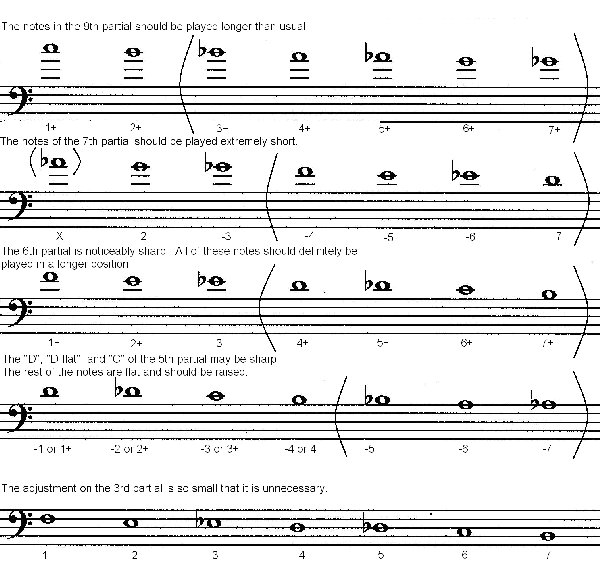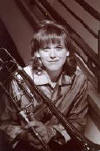| Helping
Your Trombone Section And
Why Most Trombone Slide Position Charts are Woefully Inadequate by Deb Scott, DMA SFA Instructor, Trombone |
The
trombonist can play perfectly in tune or atrociously out
of tune. A trombone student is at a definite disadvantage
when it comes to learning to play in tune. Like a string
player, he or she must learn where to “put” the
slide for each note. This takes a great deal of coordination
and will hopefully get better and better with time. Other instruments
are able to at least “land” somewhere in the vicinity
of a correct pitch by pushing down buttons or keys. With the
trombone, however, there is a lot of room for user-error. Beginning
slide position charts, a lack of student awareness about intonation
on the trombone, as well as differing intonation tendencies
among major trombone models are contributing to this wide-spread
problem.
Beginning Method Books
For the purpose of this article, I consulted
with many beginning method book slide position charts, including
several second volumes, and as suspected, I did not find one
clear accurate chart. Now, I understand that for the purpose
of simplification, beginning method books mostly use the “standard
seven” positions
without any extra adjustment indicators of longer or shorter
positions so that the student will not feel overwhelmed. However,
unless the student has access to good private teaching or a trombone-playing
band director, the student may never progress to the next step
of learning the adjustments of specific partials critical to
playing in tune. Most method books try to show adjustments
for some of the notes (such as alternate “D”) but
ignore other alterations for notes on the same partial. (One
recent method book, even publishes the wrong direction for
the adjustment for alternate “D”.)
By not introducing students to the needed alterations for each
slide position, they are not receiving all of the information
they need to play in tune.
Ear-Training
A lack of ear-training is contributing
to the problem students have of not playing in tune. Too often,
students rely on a visual indicator such as the bell to learn
where to “put” the
slide. Simple frequent reminders to students that they can learn
to “hear” intonation problems will help. Also, tell
them frequently that if they do not know if they are sharp or
flat, try moving the slide in one direction, and if it gets worse,
move it the other way. Practicing scales or arpeggios with open
fifths also helps students learn to tune specific chord tones
(i.e. the third of a major chord is played lower). For despite
a fingering chart’s best intentions, all tuning ultimately
rests with the player’s “ears”.
With digital tuners starting at less than twenty dollars, there
should be no excuse for students to not own a tuner.
Instrument Models
Not all slide positions are created equal!
Many of the popular brands of trombones do not share the same
intonation tendencies, particularly on the fifth partial. The “D” in first
position, according to the natural harmonic series, should
be flat, however, in many fine current trombone models, the “D” in
first position is actually sharp. Subsequently the “C-sharp” in
second position is also sharp and the “C” in third
position may be slightly sharp. In fact, a horn that has a
sharp fifth-partial “D” in first position
amazingly may also have a flat alternate “B-flat” in
fifth position on the same partial. It is important that each
individual student know his or her own instrument tendencies.
Again, every student should own a tuner.
How the Harmonic Series Affects Intonation
First position notes (or partials) on
the trombone are written below. Solid notes indicate that an
adjustment should be made to get the note in tune. The arrows
indicate which way the adjustment should be made. A downward
arrow means move the slide outward. An upward arrow means move
the slide inward. Note that only the partials that are octaves
of the fundamental “B-flat” are
in tune. The first position “A-flat” on
the seventh partial should not be playedbecause it is too flat.
|
 |
Chart of Positions Requiring Adjustments
Each slide position on the trombone lowers its pitch by a half-step.
Therefore each half step down from the out-of-tune partial generally
follows the same adjustments. The following chart indicates what
adjustments are needed for each out of tune partial:
(Click on image to enlarge) |
 |
What Is Most Likely Out of Tune In Your Trombone Section?
For the reasons listed above, the most likely culprits for out
of tune notes are from the sixth and seventh partials. If nothing
else, learn the sixth partial notes: “F”, “E”, “E-flat”,
and alternate “D” (1st, 2nd, 3rd, and 4th respectively)
above the staff should be played in long positions. The seventh
partial notes “G” and “F-sharp”/”G-flat” above
the staff should be played in extremely short second and third
respectively.
Tune the main tuning slide on all trombones to top of the staff “B-flat”. Although the fine tuning of the F-attachment and D-attachment will need to be left for another article, tune the tenor trombone F-attachment tuning slide to the bottom of the staff low “F” in first position (all the way in). Bass trombonists should tune their main tuning slide and F-attachment as above, then the D-attachment should be tuned to the below the staff “D” in first position.
All positions should be checked with a tuner frequently, especially middle of the staff “F-sharp”/”G-flat” and “C-sharp”/”D-flat” in 5th, low “C” in 6th, and low “B” in 7th. Remember that young students will be growing (and so will their arms.)
Summary
By following the above recommendations and passing along the information to your students, better intonation in your trombone section will certainly follow. Intonation can and should be taught to students as soon as is feasible. Adjustments for out of tune harmonics, an understanding of intonation tendencies among different trombone models in the fifth partial, as well as attention to the student’s ear training will dramatically improve your trombone section.
| If you would like to be added to the TSMP Email Mailing List and receive periodic notifications of new articles and updates to this website, then please email TSMP.
The Texas School Music
Project is a source for ideas and information
concerning pedagogical
practices in the music classroom or rehearsal hall. The TSMP is a service provided to
all music specialists by the faculty
of
the Department of Music
at Stephen F. Austin State University. Copyright ? 2002, Department of Music at Stephen F. Austin State University |
